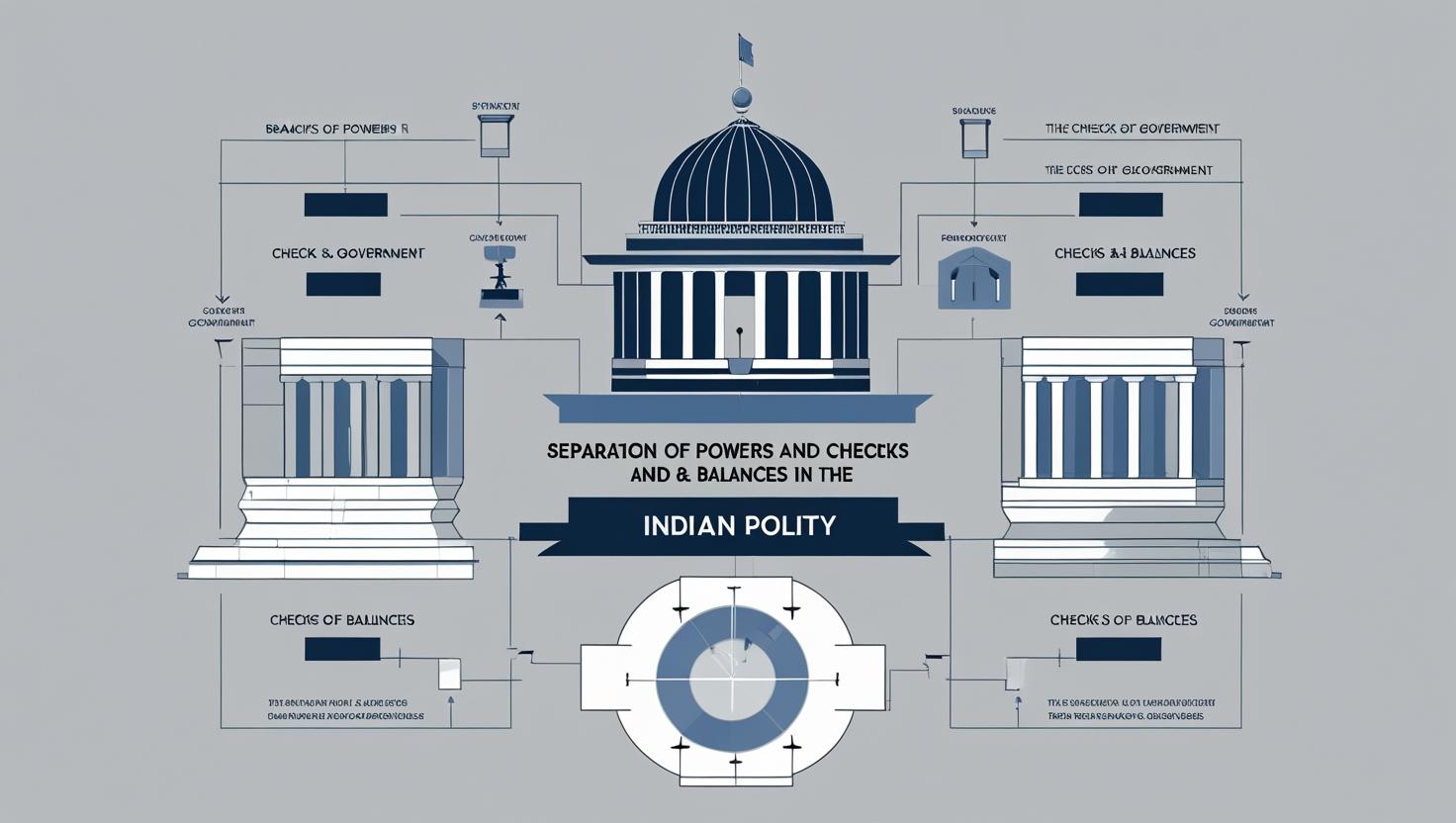1. Introduction
The principle of Separation of Powers is a cornerstone of modern democratic governance. It divides state power among three distinct organs — Legislature, Executive, and Judiciary — to prevent concentration of authority and ensure accountability.
In the Indian context, complete separation as in the U.S. is absent; instead, India follows a functional overlap model with an elaborate system of checks and balances. This is rooted in our parliamentary form of government and federal structure, where cooperation among organs is as important as their independence.
For UPSC, this topic links directly to GS Paper II (Polity) and GS Paper IV (Ethics in governance).
2. Historical & Philosophical Background
- Aristotle (4th century BCE): Early reference to separation of powers.
- John Locke: Advocated division between legislative and executive functions.
- Montesquieu (The Spirit of Laws, 1748): Formalised the tripartite division — legislature, executive, judiciary — to safeguard liberty.
- British Influence: UK has no codified constitution; relies on parliamentary sovereignty but still upholds functional separation.
- American Influence: U.S. Constitution enforces rigid separation with strong judicial review.
3. Constitutional Basis in India
The Indian Constitution does not explicitly mention “separation of powers” but incorporates it implicitly:
- Article 50 (Directive Principle): Separation of judiciary from executive in public services.
- Articles 121 & 211: Legislature cannot discuss conduct of judges except in impeachment.
- Articles 122 & 212: Judicial review of legislative proceedings is limited.
- Articles 53 & 154: Executive power vested in President/Governor.
- Articles 124–147: Independence of the Supreme Court.
- Articles 214–231: High Court independence.
The Supreme Court has recognised separation of powers as part of the Basic Structure (Kesavananda Bharati case, 1973).
4. Structure & Functions of the Three Organs
4.1 Legislature
- Function: Law-making, budget approval, oversight of the executive.
- Checks on Others:
- Impeachment of President and judges.
- No-confidence motion against the Council of Ministers.
- Ratification of emergency proclamations.
4.2 Executive
- Function: Implementation of laws, policy-making, administration.
- Checks on Others:
- President/Governor assents or withholds assent to bills.
- Appointment of judges (collegium with judicial concurrence).
- Promulgation of ordinances (temporary legislative power).
4.3 Judiciary
- Function: Interpretation of laws, protection of Fundamental Rights, judicial review.
- Checks on Others:
- Strikes down unconstitutional laws/executive orders.
- Interprets constitutional provisions.
- Supervises elections (through Election Commission’s judicial oversight in disputes).
5. Overlap in Indian Context
Unlike the strict separation in the U.S., India follows:
- Legislature in Executive: PM and Council of Ministers are part of Parliament.
- Executive in Legislature: Ordinance-making power under Article 123/213.
- Judiciary in Legislature: Judges can be removed only by parliamentary process.
- Executive in Judiciary: Appointments of judges involve executive participation.
This overlap is deliberate to ensure cooperation and coordination in governance.
6. Checks & Balances: Mechanisms
6.1 Legislative Control over Executive
- Question Hour, Zero Hour.
- Parliamentary committees (PAC, Estimates Committee).
- Approval of budget, ratification of treaties.
6.2 Executive Control over Legislature
- Summoning, proroguing, and dissolving the House.
- President’s assent to bills.
- Ordinance-making power.
6.3 Judicial Control over Legislature & Executive
- Judicial review (Article 13, 32, 226).
- Basic structure doctrine.
- Review of constitutional amendments.
6.4 Legislature’s Role in Judicial Discipline
- Impeachment of judges (Articles 124(4), 217).
7. Landmark Judgments
- Kesavananda Bharati v. State of Kerala (1973): Separation of powers is part of Basic Structure.
- Indira Nehru Gandhi v. Raj Narain (1975): Struck down a constitutional amendment violating separation of powers.
- I.C. Golaknath v. State of Punjab (1967): Judicial supremacy in constitutional interpretation.
- Minerva Mills v. Union of India (1980): Balance between Parts III and IV of the Constitution is essential.
- S.R. Bommai v. Union of India (1994): Judicial review of President’s Rule.
8. Advantages of Separation of Powers
- Prevents concentration of power (checks authoritarianism).
- Protects Fundamental Rights.
- Encourages transparency and accountability.
- Promotes specialisation of functions.
9. Challenges in Indian Context
- Excessive Executive Dominance: Strong majority governments can reduce legislative oversight.
- Judicial Overreach: Courts sometimes criticised for stepping into policy matters (e.g., PIL misuse).
- Ordinance Raj: Frequent use of ordinance power bypasses legislature.
- Politicisation of Institutions: Appointments and transfers can affect independence.
- Delay in Judicial Process: Backlog affects timely checks.
10. Reforms & Recommendations
- National Judicial Appointments Commission (NJAC)-like transparent process, but with safeguards for judicial independence.
- Strengthen parliamentary committees to review executive actions.
- Codify guidelines for ordinance-making.
- Define limits for judicial intervention in policy matters.
- Enhance autonomy of institutions like CAG, EC, and Lokpal.
11. Comparative Perspective
- U.S.: Rigid separation with Presidential veto and Senate confirmations.
- UK: Parliamentary sovereignty; fusion of powers but strong conventions.
- France: Semi-presidential system; clear constitutional boundaries but strong President.
- South Africa: Constitutional court plays active role in maintaining balance.
12. UPSC Relevance
Prelims:
- Articles related to each organ’s powers.
- Cases on separation of powers.
Mains (GS II):
- “Discuss the significance of separation of powers in Indian polity. How far has the system of checks and balances succeeded in preventing misuse of authority?”
Essay:
- “Liberty thrives where power is divided.”
13. Conclusion
India’s model of separation of powers is not rigid but organic, designed to suit the needs of a vast, diverse democracy. The system ensures that while each organ has distinct functions, there is healthy interaction and oversight.
However, maintaining this balance is a constant democratic challenge. The success of this principle depends not only on constitutional provisions but also on the constitutional morality of those in power.
A vigilant citizenry, strong institutions, and an alert judiciary remain the best safeguards to prevent concentration of power and preserve India’s democratic ethos.

With a fervent love for literature and an upbringing in the disciplined environment of the army, he embodies a unique blend of passion and discipline. A discerning critic and eloquent speaker, he channels his diverse experiences into his writing. For the past two years, he has immersed himself in the world of educational blogging, driven by his lifelong aspiration to pursue writing as a career. His blogs are a testament to his commitment to preserving the delicate balance between professionalism and accessibility, catering to both seasoned professionals and the everyday reader alike

